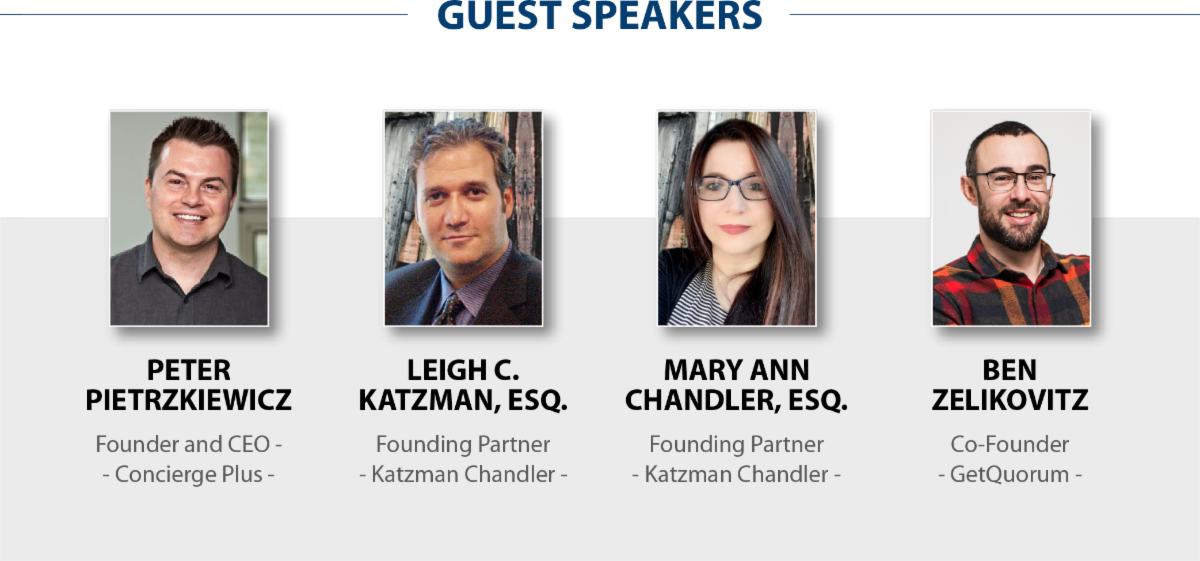Maintaining a positive resident experience throughout the pandemic and post-pandemic will require help from technology made specifically for property management.
The coronavirus pandemic has disrupted the day-to-day operations of our industry across North America, forcing us to dramatically alter our working methods and approach. Property managers have had to adapt and respond quickly to unprecedented operational challenges that make managing communities on-site impractical in a post-COVID-19 environment.
Many industry leaders expect their workforce to become permanent work-from-home employees after the pandemic ends, leaving no choice but to adopt tech or risk permanent closure.
Resident experience management software can help, but choosing the right solution requires a 5 step process and understanding of how technology is changing.
Step 1: Map out the tasks that your association performs
The first step is to map out the tasks that your staff need to do. It can be challenging to figure out what tasks even need to be mapped out. Tasks carried out by staff differ from association to association. From handling packages and screening visitors to dealing with service requests and processing amenity bookings. For each one of these tasks you must find a process that is efficient and works well not only for your team but also for the residents to alleviate frustration.
Question: Who can help you map these tasks out?
Answer: You can engage your property management team, a committee, or board members to help you understand what tasks need to be optimized.
Step 2: Establish optimal processes for each of those tasks
The next step is to come up with the processes needed to handle each of the tasks. In the past this was cost-prohibitive. Only large associations or those with big budgets could afford to do something like this.
Question: Where do you start optimizing each task?
Answer: Begin by understanding what parts of the task are most time consuming or frustrating to residents. For example: if residents can’t access the availability of your amenities from wherever they are, at any time, they are more likely to be frustrated and less likely to make a booking. This will result in lost revenue for the association.
You need to work with someone who has done this before and has been successful at creating efficiencies within associations. This is the only way you will come up with an optimal process. There are consultants you can hire that offer services to associations along these lines.
Step 3: Train your team on the new processes
The next step is to train the management team and all your staff. Training videos are extremely effective at explaining processes to team members and will save managers significant time.
Question: Who will train your team and ensure they are following the established processes?
Answer: Videos and online tutorials will help familiarize existing team members with the new process. This same content will be shown to new team members to facilitate their training and ensure everyone gets the same information. Making sure that every team member is following each established process is critical to ensure a consistent experience for residents and that no details are lost.
Step 4: Educate your residents on the new processes
Next, you need to educate residents on the available tools and how to use them. Using a platform to house community content allows property managers to communicate more effectively with residents.
Question: Who will explain this to your residents?
Answer: Residents are already busy with their everyday lives. They need to have a quick understanding of where to go and what to do to accomplish these interactions. A single, easy-to-use, intuitive platform will help ensure that all residents know what to do.
Step 5: Use technology to execute those tasks daily
Finally, you and your team need to execute the tasks.
Technology has developed significantly in the past five years and has become a huge time saver for property managers.
Question: What type(s) of technology do you need for these tasks, and what is currently out there?
Answer: Here are some suggestions for technology you will need to acquire to accomplish this. You will need to organize your resident information with a spreadsheet (Microsoft Office 365 and/or Google Sheets). You can create another sheet to record packages and deliveries, and their pick-up/drop-off information. You’ll need to be able to reach residents by email with important announcements using Constant Contact, MailChimp, or a similar platform. Service requests will require you to use an online form from Survey Monkey. You can create an additional form on Survey Monkey for each amenity you want to be able to have residents book online. Amenities will also need a shared calendar: a Gmail account will allow you to do that.
We don’t recommend the above as your association needs to leverage technology to save time, money, and be more modern. Reducing the number of manual interactions your team must do daily will enable them to save hundreds of hours each month.
Why invest in a resident experience management platform?
Temporary closures are on the rise because of the lack of communication with residents and staff. While Microsoft Office 365, and MailChimp are popular solutions you might think to try, they aren’t built for the needs and challenges of property management.
We recommend using a resident experience management platform that is designed and built from the ground up, specifically for managers and residents, with the needs of property management industry in mind.
The benefits of such a platform are many:
-
You can manage your building from any device, whether it’s a desktop or laptop, tablet, or mobile phone. Residents can log in from wherever they are and communicate with other residents and/or the property manager.
-
It is scalable for portfolio expansion and has enterprise-level flexibility and reliability.
-
It houses all front-office and back-office data in a single, connected system.
-
Many residential property managers report reduced cycle times and lower costs of ownership along with fewer errors and inefficiencies that are common with separate systems mentioned above.
-
It can accommodate multiple property types (HOAs and Condominiums).
-
It can easily accommodate language translation and other elements of multinational portfolio management.
-
It integrates with third-party tools such as packing tracking software, allowing for smooth parcel management.
Concierge Plus to the rescue
Unfortunately, most managers are struggling with delivering great resident experiences as they don’t have a proper platform designed to fulfill their needs. What they have is either a static website or multiple tools that aren’t suited for managing a community, but as we are entering a post-pandemic environment with social distancing taking off, they need a resident experience management platform designed for managing modern HOAs and Condominiums.
Our best-in-class resident management platform is designed to make life easier for Front Desk and Building Staff, Residents, and Property Managers. Our web-based, modular solution is fully scalable and customized to meet the needs of any sized community. It also saves time and money while delivering better customer service to residents and board members.
Learn how to communicate with your residents in an age when we are practicing social distancing and the benefits of hosting a virtual meeting. Watch our webinar titled Community Association Technology: Resident Communication, Virtual Meetings and Electronic Voting in a post-pandemic environment.





Share This Post